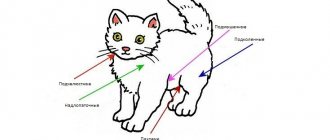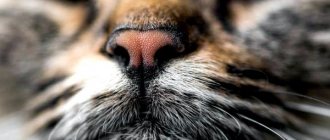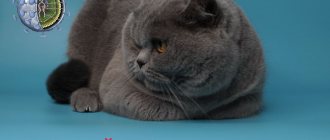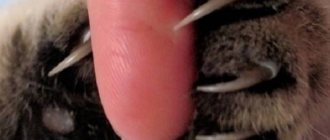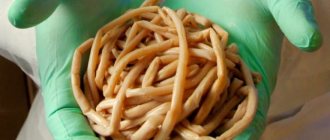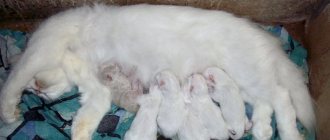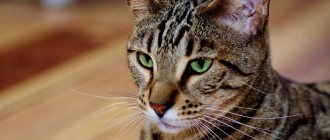Despite the fact that cats naturally have a well-developed sense of smell, cases of poisoning in them are not uncommon. Cats are very curious animals and quite often turn their attention and taste objects that interest them on the floor or ground.
A cat, unlike a dog, cannot be taught not to pick up food from the ground, nor to hunt mice, insects and birds.
The main reason that can cause poisoning in a cat is the hunting instinct inherent in them during the process of evolution.
When walking outside, cats take great pleasure in hunting for mice, small birds, butterflies and other insects. Outdoor cats are not averse to trying growing green plants, which are sometimes poisonous.
Often the cause of food poisoning in cats is eating food contaminated with bacteria and prohibited “treats”.
Causes of poisoning in cats
Poisoning in cats occurs as a result of:
- Eating low-quality and spoiled food products. Food left in a bowl often spoils, especially when owners leave it for the cat to eat all day. Your cat may find spoiled food in the trash. Spoiled food in cats is the most common cause of animal poisoning.
- Medications. Drug poisoning in cats occurs during self-medication, when medications are given to the cat in an increased dose, giving drugs that are prohibited for cats. Cats can eat medications you use in their treatment that are left in an accessible place.
- Poisoning with rat poison. In cities and country houses, due to the large number of rodents (mice, rats), zinc phosphide is used as control when carrying out deratization work. This drug is used in the form of bait. Its actions are based on the fact that the anticoagulant included in its composition disrupts blood clotting in the person into whose body it enters. The anticoagulant accumulates (cumulates), so death does not occur immediately, but gradually. Poisoning by rat poison in a cat can occur not only due to eating bait with it, but also after eating a poisoned rodent - mouse, rat (poisoning of animals with zinc compounds).
- Eating poisonous plants. Usually cats, while walking, feel which herbs they come across during a walk can be eaten and which are dangerous. Living in a room, cats often, out of curiosity, and also in order to cleanse the stomach of lumps of hair and other substances that have entered the stomach, begin to try indoor plants, which are sometimes dangerous for them. Dangerous plants are usually classified as: ficus; alocasia; ivy; Dieffenbachia; dracaena; digitalis; syngonium; philodendron; exotic plants.
When engaging in indoor floriculture, try not to purchase plants that can cause the development of poisoning in cats. For cats that do not leave their house or apartment, taking into account the physiological needs of the cat’s body, it is advisable to purchase containers with sprouted grass and cereals from a veterinary pharmacy.
Household chemicals. Poisoning in a cat can occur if owners do not thoroughly wash away detergents from the cat's feeding dishes. When sniffing, licking and when a cat chews household chemicals in the bathroom. A cat can become poisoned by household chemicals by inhaling them through the lungs, fur, etc.
Bites of poisonous insects, snakes. Being a predator by nature, a cat, once outside, especially in the summer, begins to realize its predatory instinct, trying to catch bees crawling on the flowers of plants. If a cat has not previously interacted with bees, then this can end quite sadly for her. With the onset of the warm season, bees in search of nectar are regular visitors to flowering plants, and of course the bee is not to blame when a cat or kitten tries to play with it (The cat was bitten by a bee (wasp) - what to do?).
Severe helminthic infestation. Worms in a cat's body, in addition to mechanical damage to tissues and the development of intestinal bleeding, cause severe poisoning of the body (worms in a cat).
Pesticides, insecticides, herbicides used by owners for garden crops and ornamental plants. Cats are very clean animals and constantly take care of their hygiene. When washing the face with a paw, after visiting plants treated with pesticides, it introduces these substances into the oral mucosa, which can cause poisoning.
Distemper: how to deal with this cat disease
Cats are susceptible to many diseases.
One of the most dangerous is plague (panleukopenia). This is a fatal disease that is important to recognize in time. If measures are not taken in time, 90% of cases end in death for the pet.
Therefore, you should study the main signs of distemper in order to protect your cat from death. This viral disease is not dangerous for humans.
Risk group
Cats under 6 years of age are at the least risk of developing panleukopenia. Over the years, the animal's body becomes depleted. Its protective functions become weaker. And then plague infection becomes practically unhindered.
Cats aged 6-8 years are considered a high risk group. But the greatest danger of infection is in kittens and young animals under 1 year of age. If a pregnant cat gets sick, she miscarries, the cubs become nonviable or mummify.
Methods and ways of infecting cats with distemper
The virus that causes distemper enters the external environment along with the urine, feces, and saliva of sick cats, as well as those that have recovered from this disease. You can become infected with panleukopenia through hygiene items that come into contact with your cat.
Pets become infected after drinking from a container from which a sick animal drank, while walking on the street where a carrier of the virus was walking. It is not necessary to have close contact. Even if the animal has already been ill, the distemper virus can survive in the house for 6-12 months. After recovery, the cat is still considered a carrier of the virus.
It is possible that feline plague can be transmitted in utero or that it can be carried by blood-sucking insects. Humans can also carry the virus. But he himself does not suffer from the plague. The infection can be brought on by shoes or dirt particles on clothing. Unfortunately, the causative agent of the disease cannot be eliminated by disinfecting the premises.
Symptoms of poisoning in cats
Depending on the amount and toxicity of the poison, the duration of its effect on the cat’s body, the symptoms of poisoning may not always be very pronounced.
Depending on what the cat was poisoned with, the degree of toxicity and the amount of toxic substance that entered the animal’s body, the first symptoms of poisoning may appear after 6-8 hours. When poisoned by potent toxins or poisonous plants, symptoms of poisoning in a cat appear a few minutes after entering the gastrointestinal tract.
Symptoms of poisoning in cats:
Nausea progressing to vomiting. Before vomiting begins, the cat becomes very nauseous, the cat behaves restlessly, randomly moving around the room from place to place, makes constant swallowing movements, and meows pitifully. After some time, the cat begins to cough, tilt and stretch its head forward, and breathe frequently and deeply. After all this, the cat begins to contract in the abdomen and throat, ending with vomiting (vomiting in cats).
Diarrhea. During the day, a healthy cat goes to the toilet 1-2 times. With diarrhea, the cat begins to defecate much more often, while the volume of liquid feces in the cat's litter box becomes smaller each time, the feces become from pasty to watery, the color of the feces varies from black to red (with bleeding in the gastrointestinal tract) - diarrhea in cats.
Severe drooling. When a cat is poisoned, owners often notice severe drooling (the cat is drooling).
Decreased appetite to the point of refusing to feed.
Increased thirst. As a result of poisoning, the cat experiences severe dehydration (loss of fluid as a result of vomiting and diarrhea) and the cat drinks a lot to replenish lost fluid.
A sharp decrease in body temperature; sometimes a poisoned cat may have a fever.
Inadequate reaction of the pupils to light or lack of reaction (the pupils are constantly dilated or constricted).
Weakness, apathy, unsteady gait and drowsiness of a poisoned cat.
Pain on palpation of the abdominal area.
Visible mucous membranes become pale and icteric.
Inappropriate reaction to external stimuli.
In case of severe poisoning, the cat experiences shortness of breath, an increased pulse rate, and cardiac arrhythmias (bradycardia, tachycardia, arrhythmia). Poisoning with chemicals and poisons leads to impaired coordination of movements, paralysis and paresis of the limbs, severe agitation, and muscle spasms of individual muscles appear.
As a result of poisoning, the cat can be aggressive or, on the contrary, depressed. They try to hide in a dark corner of the room and meow constantly.
When bitten by insects, a cat develops allergic reactions, dermatitis (dermatitis in cats).
Effect of ethanol
There is a myth that ethanol is a natural metabolite. It is not true. There is not a single reaction that occurs inside a living organism that would result in the production of ethanol. At the same time, there are many bacteria in the intestines whose task is to produce vitamins, process fiber, and some of them produce ethanol (about 3 grams per day). However, there are no such microbes inside the cat’s intestines; they exist only in the gastrointestinal tract of humans and other omnivores and herbivores.
Ethanol is a neurotoxic poison, a carcinogen and a drug that suppresses the activity of the central nervous system. Suppression of the nervous system is possible up to coma and death. The lethal dose is 5-8 ml of alcohol per kilogram of weight, that is, for a cat this is about 3-4 tablespoons of 40% vodka (it contains 20 ml) or teaspoons of pure ethanol.
Stages of intoxication with increasing dose
When consuming small doses, the “reward system” is activated, the active substance of which is dopamine. The purpose of these reactions is to motivate the animal to perform certain actions: sex, successful hunting, victory over an opponent in a territorial fight. However, you should not think that you can give your cat alcohol to “relax” it, since the “useful” dose is too small - literally 0.1 ml of ethanol or 0.3 ml of vodka. It is inconvenient to administer such an amount of alcohol even through a syringe.
A further increase in the dose depresses the activity of the central nervous system; every person has seen all these aspects more than once or even experienced it on himself:
- the brain’s ability to concentrate on various thoughts decreases, only one idea remains (usually not a good one);
- coordination of movements is impaired;
- the hunger center is stimulated, that is, the animal’s appetite increases;
- the last stage is narcotic dreamless sleep.
Sobering up
It begins simultaneously with intoxication, but since this process is slow, its result is felt only after stopping drinking alcohol.
Sobering up is directly related to the destruction of ethanol.
It goes in 2 stages:
- Decomposition of ethanol to acetaldehyde . Several systems in the body are responsible for this; the transformation of alcohol occurs both inside cells and in the blood, liver and intercellular fluid.
- Decomposition to acetic acid . This stage of decomposition takes place exclusively inside the cells, which is why the speed of this stage is greatly inhibited.
It is acetaldehyde that is the main cause of all the unpleasant sensations of a hangover. Moreover, the second stage takes much longer than the first. As a result, due to the difference in speed, acetaldehyde accumulates, which is not destroyed immediately, resulting in a hangover.
First aid for poisoning
Having noticed the first symptoms of poisoning, cat owners should immediately contact their veterinary clinic. Where veterinary specialists, after conducting a clinical examination and diagnostic studies, will carry out the necessary therapeutic measures.
Considering that some poisonous substances have an immediate effect on the vital organs of the animal, and sometimes owners do not have the opportunity to urgently contact their veterinary clinic or call a doctor at home, owners must be able to provide first aid in case of poisoning.
In the case when you are sure that your cat’s poisoning is caused by poor-quality food, to normalize the cat’s general condition, we give the cat emetics (apomorphine, detox).
In order to neutralize toxins in the stomach and provoke vomiting in the cat, through a syringe without a needle, pour a weak solution of potassium permanganate and baking soda into the oral cavity at the rate of one part soda to four parts water.
To cleanse the stomach and provoke vomiting, you can pour warm boiled water or a decoction of medicinal chamomile into the cat’s mouth with a disposable syringe every 15 minutes. By this we achieve a reduction in intoxication and dehydration of the body.
Warm enemas from decoctions of medicinal herbs (plantain, yarrow, St. John's wort, chamomile) will help alleviate the condition of a poisoned animal.
After carrying out these cleansing procedures in order to remove the toxins remaining in the cat’s body, crushed activated carbon (1 tablet per 5 kg of body weight) or enterosgel, atoxil is given inside.
A good result in case of poisoning of cats can be obtained by giving mucous coating substances that cover the gastric mucosa and stop the absorption of poisons into the blood. Coating substances usually include flax seed decoction, rice decoction, chicken egg white, and tannin.
In case of poisoning with heavy metal salts, it is necessary to use raw chicken protein, then pour a warm saline solution or a large amount of boiled warm water into the cat’s mouth to induce vomiting.
In the case where cat poisoning is caused by household chemicals as a result of contact with the fur, the fur is thoroughly washed with water using laundry soap or animal shampoo. Induce vomiting by placing 8-10 grams of table salt on the root of the tongue. Decoctions of medicinal herbs are poured into the oral cavity with a syringe, and activated charcoal is given.
In case of acid poisoning, the cat must be given a solution of soda to drink (1 teaspoon per 200 ml of water). Inducing vomiting is prohibited.
Alkali poisoning. Take 2.5 tablespoons of lemon juice and mix with 3 tablespoons of water and drink it to the cat. Inducing vomiting is prohibited.
When stung by a bee. Carefully examine the site of the bee sting and try to remove the bee sting. We squeeze the wound from a bee sting with two fingers and try to remove some of the bee venom that has entered the wound. We treat the wound from a bee sting with any disinfectant. To remove the tumor, make a compress of baking soda and boiled water. Apply ice or a cold compress to the site of inflammation. To relieve an allergic reaction, we give an antihistamine:
Prednisolone. At home, 0.5 tablets are required. Turn the tablet into powder, dilute it with water and pour it into the cat’s mouth. In cases where immediate relief of an allergic reaction is required, the cat is given an intramuscular injection and 0.5 ml of solution is injected.
Dexamethasone. Used for obvious signs of allergy - vomiting, nausea, difficulty breathing. An injection is given with a solution of 0.2 ml.
Diazolin. It is recommended if a bee has bitten a kitten, an adult cat, or a cat. Dose – 0.5 tablets at a time. On the first day, an antihistamine is given three times.
If swelling is severe, it may be helpful to give your cat a diuretic.
We give the stung cat rest and calm it down.
Is it possible to cure erectile dysfunction?
Treatment of impotence in men is carried out comprehensively and always taking into account the cause. For diagnosis, you need to see a doctor - a sex therapist. He will examine the genital organs, ask questions regarding the nature and frequency of erection, and also prescribe the necessary examinations: duplex ultrasound and computed tomography of the penis, rheography, etc.
Treatment of vascular impotence is carried out with the help of drugs that dilate blood vessels. If there is a lack of testosterone, appropriate replacement medications are prescribed. Phosphodiesterase type 5 inhibitor drugs show a good effect in the treatment of erectile dysfunction in older men. They promote erection, but do not affect the nature of the problem.
In addition to drug treatment, the following are used:
- psychotherapy;
- vacuum therapy;
- massage;
- Exercise therapy.
At the clinic Dr. AkNer practices the most modern and effective treatment methods. Here, men are assisted by a urologist, andrologist and sex therapist with more than 40 years of experience. After treatment at the clinic, 99% of men completely restored their sexual function, so you can trust us with your delicate problem.
Treatment of poisoning in a veterinary clinic
Before starting to treat a cat with poisoning, the doctor must obtain from the owner information about what, in the owner’s opinion, the cat was poisoned with, whether there was vomiting (it would be a good idea for the owner to take a sample of the vomit with him), whether there was diarrhea, what chronic diseases your cat has, and etc. A quick clinical examination is carried out and resuscitation measures begin.
The cat is given a drip with 40% glucose. General stimulants (Gamavit, Katazol, Vitam, Vitamin C) and detoxifying drugs, hepatoprotectors (Essentiale), cardiac drugs (camphor, caffeine, cordiamine), antiemetics (Cerucal), and antidiarrheal drugs are administered intravenously. In case of severe poisoning, the drip to the cat is repeated every other day.
To normalize water-salt metabolism, the cat is injected intravenously with Ringer's solution. When treating poisoning, veterinary specialists also use antispasmodics - no-shpa, baralgin.
In order to speed up the elimination of poisons that have entered the body, diuretics are prescribed.
Depending on the general condition of the body, a veterinarian may additionally resort to symptomatic treatment.
Bibliography:
- Lelevich S.V., Velichko I.M., Lelevich V.V. Neurochemical aspects of alcohol intoxication. - Journal of Grodno State Medical University, 2022. - T.15(4).
- Anazarova S.A., Izverova A.A., Kadura A.A. Alcohol intoxication in children and adolescents. - Bulletin of medical Internet conferences, 2013. - T. No. 3 (11).
- Lelevich S.V. Metabolic correction of alcohol intoxication. - Medical news, 2016. - No. 9.
Need some advice?
OR CALL A DOCTOR
CALL!
+7
Benefits and harms
Alcohol has a detrimental effect on the entire body if you give your cat too much of the drink. First of all, the liver and stomach suffer. Vodka has a diuretic effect on the kidneys, therefore, in addition to toxins, beneficial vitamins and substances are removed from the animal’s body. Alcoholic drinks destroy the walls of blood vessels, disrupt the functioning of the heart, increase arrhythmia and increase blood pressure. Alcohol also has a negative effect on the nervous system and dulls vision.
However, despite all the listed disadvantages of vodka, there are also positive qualities. It has antiseptic and antibacterial properties. Various herbal tinctures, elixirs, balms and rubs are prepared using alcohol. They are used externally internally as a cure for many diseases.
Benefits and harms
Alcohol has a detrimental effect on the entire body if you give your cat too much of the drink. First of all, the liver and stomach suffer. Vodka has a diuretic effect on the kidneys, therefore, in addition to toxins, beneficial vitamins and substances are removed from the animal’s body. Alcoholic drinks destroy the walls of blood vessels, disrupt the functioning of the heart, increase arrhythmia and increase blood pressure. Alcohol also has a negative effect on the nervous system and dulls vision.
However, despite all the listed disadvantages of vodka, there are also positive qualities. It has antiseptic and antibacterial properties. Various herbal tinctures, elixirs, balms and rubs are prepared using alcohol. They are used externally internally as a cure for many diseases.
Nutrition
The best treatment for diarrhea is fasting. But it should last no more than 2 days. In the next 24 hours, you need to force-feed 4 times a day, in small portions, usually the total dose is halved.
Water should always be poured. The dishes must be disinfected.
From the diet you need to exclude all dairy, carbohydrates, starch contained in foods, smoked foods, and sweets. Limit fatty foods. Use easily digestible foods: rice, boiled yolk, boiled chicken.
Cats accustomed to dry food will have to give it up for a while. To do this, purchase special canned food in the store that is gentle on the gastrointestinal tract. You can switch to your usual diet after complete recovery.
